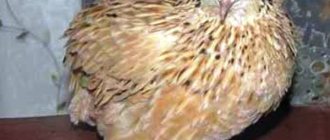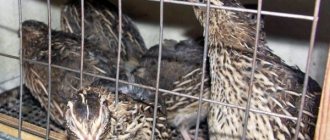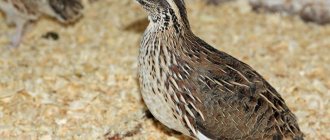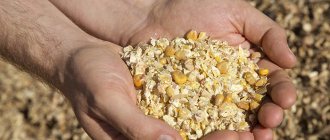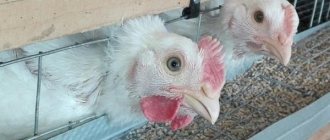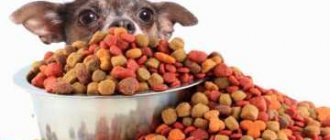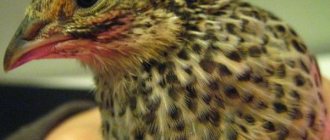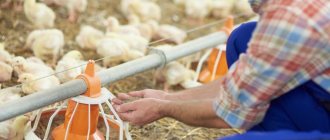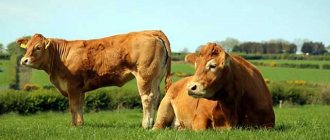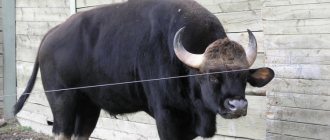Benefits of compound feed
By using compound feed in feeding livestock, you get a lot of benefits:
- Save time on food preparation.
- The bird receives adequate nutrition - it grows quickly and lays many eggs.
- Quails grow healthy, get a lot of energy, and produce strong and numerous offspring.
- Compound feed is easy to store and convenient to give to birds.
- It makes it easier to control the amount of food taken - you are sure that all the quails have received their portion.
When choosing feed, you need an individual approach - the direction of poultry farming (meat/eggs) and the age of the bird. At the same time, the three-stage feed system – “start-growth-finish” – looks extremely convenient, which allows you to feed quails from the first days until slaughter.
Types of ready-made feed
Specially developed formulations for young and adult birds allow the poultry farmer to save time by feeding the livestock only with dry feed. In this case, there is no need to add additional additives, vitamins, or herbs to the quail menu.
A line of compound feeds has been created for quails: for young animals (Start, Growth, Finish for meat breeds), for parent flocks and laying hens.
For chicks
For quails from birth, a composition called Start is provided. It is a grain or small granules that contain nutrients and vitamins that the baby needs for active development. The protein content in this food is 24–28%.
From the first week until the start of egg laying, young quails of egg breeds are fed with the compositions DK 50 and DK 51. For fattening chicks, the compositions DK 53 and DK 53–1 are used.
For an adult bird
Food for quails that have begun laying eggs is not as nutritious as food for chicks, but includes a wide range of vitamins and minerals. Its marking is DK 52.
Traditionally, the feed mixture for quails from Purina has received positive reviews.
What does compound feed consist of?
Let's look at the main components of feed for quails.
Squirrels
Protein needed:
- for chicks - for active growth;
- for laying hens - to maintain health during the period of active egg laying.
Protein consumption standards for quail:
- The chick, having just hatched from the egg, should receive food with 24-27% protein. This norm is observed for 30 days. Proteins should be of two types - animal and vegetable.
- Having crossed the one-month mark, quail require slightly less protein - 17-24%. This rule is valid for two weeks.
- Adult birds going for meat require feed containing 16-17% protein.
- Laying hens - about 21% protein.
Carbohydrates
The amount of carbohydrates the bird receives along with the feed determines its energy level. Errors in the selection of food lead to a decrease in growth and reproduction rates.
The main source of energy in animal feed is cereals. To prepare grain mixtures, the following are usually used:
- corn;
- millet;
- barley;
- wheat.
Oats in combination feed should be treated with caution. Unpeeled oats are especially dangerous - their shells can clog the esophagus of chicks, which will lead to illness and even death of the brood.
Other nutritional supplements
Additives help replenish feed with minerals, amino acids and vitamins:
- cake and meal from soybean and sunflower seeds are sources of vitamins E and B;
- yeast is a source of enzymes and vitamins, pantothenic acid;
- green food;
- meat and bone meal – meets protein needs;
- salt is an important mineral for quails;
- fishmeal – contains a lot of protein, amino acids and fat;
- chalk and crushed shell rock are sources of calcium.
Compound feed for quails may differ in digestibility, calorie content and balance.
Advantages and disadvantages of compound feed
The main advantages of industrial mixtures for feeding quails, which cover all the disadvantages, are the significant time savings for the poultry farmer when servicing the livestock and their balanced composition.
The finished product is simply poured into the feeder and the bird is provided with clean water; the feed does not require any additional preparation. If you have a population of several hundred or even thousands of birds, this is the most significant advantage.
For quails with their intense metabolism, the presence of all the elements necessary for the body in food is especially important. An imbalance in the nutrition of quails leads to a decrease in productivity.
The disadvantages of factory-made feed include its high cost (at least 40 rubles per 1 kg) and short shelf life (about 3 months).
This is due to feed additives added to the feed mixture, which react with each other and oxidize in air, losing effectiveness.
When buying food, you need to make sure that its expiration date has not expired. Store the product in a dark, dry and cool place, at a temperature no higher than +24 degrees.
Industrial type of feed
Beginner poultry farmers who are afraid to feed their pets homemade mixtures are especially drawn to purchased feed. Experienced farmers use both nutrition options:
- buy industrial feed;
- Prepare feed mixtures yourself.
Industrial feed is sold in packages. See the diagram for feeding quails with various feeds:
We will also consider each type of complete feed for quails separately.
For chicks
Starter feed is needed for hatched chicks. Young animals are fed with them until 21 days. Preparing starter food is a difficult task, it is better to buy it. There will be few expenses - the chicks eat little, but there will be a guarantee that they will receive a complete diet. Even a slight deviation from the composition can negatively affect the development of the bird. The following foods are sold for quail chicks:
- PK 5-41 is a complete starter feed. Cereal 3 x 3 mm. They are fed from the first day of life until the 4th week. Forms cellular and humoral immunity, accelerates weight gain. Consists of corn, wheat, soybean cake, sunflower meal, fish meal, feed yeast, limestone, feed phosphates and vegetable oil. Also contains a vitamin and mineral mixture, antioxidant, amino acids, enzymes and an antibacterial complex.
- PK 6-6 – feed for replacement young animals. Give at 4-6 weeks. It differs from the starter feed in the presence of corn gluten, wheat bran, vegetable fat, soda and a mold inhibitor. The remaining ingredients repeat the composition of the starter feed.
- PC 3-8 – complete granulated food made from natural products. Give at 5-6 weeks. The composition is similar to the previous one, but the components are selected in different proportions. Feed PK 3-8 is intended for young animals raised for eggs, therefore it contains a higher content of calcium, sodium, and chlorine.
When feeding young animals, any food is soaked in water.
For an adult bird
Growth feed is given to quails from 21 days. Feeding is carried out until the age of 1.5 months. When choosing feed, take into account the direction of breeding - for eggs or for meat:
- PC 1-24 – given to laying hens during the productive period. Feed in the form of grains 3 x 3 mm. Consists of wheat, soybean oil, soybean and sunflower meal. It also contains phytase, multi-enzyme and vitamin-mineral complexes, and an antibacterial drug.
- DK 52-4 – grits 2-3 mm. Complete feed for laying hens, given from the 7th week. Consists of wheat, bran, corn, meal, salt, fish meal and fish oil. The composition also contains Bacell enzyme, soda, lime flour, and other components.
- PK-1P – recommended for meat breeds of quail. Can be given from 22 days. High-calorie, balanced and easily digestible food. It is recommended to mix with herbs. Contains grain, grain processing products, meal, corn, proteins and vegetable fats. Enriched with premix.
- DK-52 – compound feed for laying hens. Give from the 7th week. Produced in the form of grains. Improves poultry productivity and strengthens the shell. Balanced feed providing 85-90% productivity.
- DK-53 – for birds intended for fattening for meat. Granulated complete feed for fattening from the 7th week. The composition is standard - grains, bran, meal, etc. A complete set of vitamins, antioxidants and bioactive substances.
More details about each type of produced feed for quails
Let's start with starter feed for quails, which is quite problematic to prepare at home. Many experienced quail breeders prefer to buy it for several reasons. Firstly, it is difficult to prepare and secondly, small chicks eat little, so its consumption is small, and therefore the costs are small. It is also necessary to take into account that day-old quail are extremely demanding on the quality of feed and even minor violations of the recipe can negatively affect not only their growth, but also their survival. It is for this reason that it is not recommended to make starter feeds yourself at home. It is preferable to use proven food made at the factory.
Compound feed for quails is available in two types for feeding small chicks and for adult birds. In terms of composition and recipe, they are largely similar, but there are also nuances.
Compound feed for young animals
From the first days of life, the use of feed type PK-1 is recommended. This feed for quails is the main one. Its main part is corn and wheat with the addition of wheat bran and barley. One of the most important elements of PC-1 is bone meal, its composition is about 40 percent, it is necessary for the rapid growth of birds and weight gain. Salt is also added to this type of feed.
Feed for young animals PK-1P
The next type of feed, PC-2-1, is based on wheat and corn, but unlike the above, it contains fat, fish meal and sunflower oil. Limestone and salt are also added.
Another commonly used type of feed is PK-5. It is based on about 60 percent wheat and corn grains. The composition of the protein supplement is about 35. It consists of sunflower meal, fish oil, sunflower oil and fish meal. The composition of the mineral part is approximately 5 percent and includes salt, chalk, lysine, and phosphate. This type of feed is preferred for fattening small chicks and productive females.
Many poultry farmers claim that any food can be suitable for 1-2 day old chicks, but it must be given in a soaked form.
Feed for adults
Compound feed PK-2-2 is very similar in composition to PK-2-1, but the proportion of grain and protein parts is slightly different.
PK-4 feed is based on wheat, corn and barley; wheat bran and flour are also added. The mineral supplements consist of limestone, shell and salt.
In PK-6 feed, the grain part is 65 percent and consists of barley, wheat and corn. The protein part is 30 percent and consists of yeast, sunflower cake, and fish oil. Minerals 5 percent - lysine, limestone, phosphate.
Pelleted feed
Homemade feed: recipes
Compound feed for quails prepared at home will cost less than industrial feed. Beginning farmers use recipes from experienced poultry farmers. As quails are raised, most poultry farmers develop their own recipe.
The basis of homemade feed is grain crops, minerals, fruits and vegetables are added to them.
It is important to prepare the ingredients correctly:
- clean vegetables and fruits from rot;
- rinse in water, and then cook for 45 minutes, changing the water;
- cool and grind to a paste consistency.
Onion or garlic peels should not get into the food - they can clog the quail's esophagus.
In the video below, a specialist explains how to prepare feed for quails from inexpensive ingredients that are available at any collective farm market:
Recipes for adult quails
In order for quails to grow and not get sick, they should not eat grain alone. A prerequisite is the presence of protein (22%) and microelements.
Recipe No. 1. Table 1 shows the norms of products for preparing 1 kg of feed.
Table 1
| The product's name | Weight, g |
| shredded wheat | 300 |
| cake | 170 |
| crushed corn and barley grain | 150 |
| wheat bran | 70 |
| small shell and feed yeast | 30 |
| fish and meat and bone meal | 20 |
| peas and unrefined sunflower oil | 20 |
| chalk | 13 |
| premix | 10 |
| salt | 2 |
All ingredients are thoroughly mixed. Birds are fed food in the form of a mash; it can be dry or wet. Water or curdled milk is poured in right before the feed is dispensed. The consumption of homemade feed made according to this recipe is 1 kg for 40 days (for one quail).
Recipe No. 2. This is an alternative option with a higher corn content. Table 2 shows the proportions of ingredients.
table 2
| The product's name | Content, % |
| corn | 40-42 |
| wheat | 16 |
| soybean meal | 10 |
| sunflower meal | 10 |
| meat and bone meal | 5 |
| fish flour | 5 |
| chalk and shells | 6 |
| yeast | 4 |
| grass flour | 2 |
You can add flax and hemp seeds - quail love them very much. It is also recommended to introduce salt and premix - 0.5% each.
Recipes for laying hens
Egg-laying quails must receive special nutrition. They are given at least 30 g of food per day. If a poultry farmer wants to get high-quality eggs, hens must be provided with protein - it should be 26% in the feed. Feed for laying hens must contain:
- base - compound feed or cereal;
- proteins - for example, soy, peas, lentils, blood of slaughtered poultry;
- calcium – egg shells;
- additionally - plant seeds, barley flour, fish roe, bones and offal, maggots and meat and bone flies;
- minerals - shells and yeast;
- vitamins – potatoes, onions, cabbage, carrots.
If laying hens have digestive problems, rice is added to the feed. Quails also benefit from yogurt.
Recipe No. 1. Example of a recipe for laying hens. Table 3 shows the percentage of ingredients.
Table 3
| The product's name | Content, % |
| sunflower cake | 12 |
| soybean meal | 7 |
| equal parts wheat and corn | 55 |
| peas | 3 |
| chalk | 1 |
| sunflower oil | 1 |
| feed yeast | 5 |
| bone flour | 5 |
All ingredients are thoroughly mixed. You can add a premix.
Recipe No. 2. Feed for laying quails, enriched with calcium.
Table 4
| The product's name | Weight, kg |
| powdered milk | 4 |
| corn | 20 |
| wheat | 19 |
| yeast | 6 |
| millet | 12 |
| bone flour | 12 |
| sunflower cake | 5 |
| ground shells | 2 |
You can add minerals to the composition - chalk or crushed shells.
Recipes for chicks
Recipe No. 1. Food for chicks is prepared from crushed grains.
Table 5
| The product's name | Weight, g |
| Wheat groats | 100 |
| corn | 400 |
| barley | 100 |
| unrefined sunflower oil | 5 |
| bone flour | 10 |
| salt | 10 |
| chalk | 10 |
This amount of food is designed to feed the chick for a month. The food is given dry or soaked. This is the basis of the diet of small quails. It is recommended to add to it from time to time:
- greens - dill and parsley;
- crushed eggshells;
- minced meat - fish or meat, low-fat cottage cheese.
From 14 days, gravel and small shells are introduced into the diet.
Recipe No. 2. This recipe is universal, it is suitable for both chicks and mature birds.
Table 6
| The product's name | Weight, kg |
| corn | 40 |
| cake | 5 |
| wheat | 15 |
| fish flour | 10 |
| meat and bone meal | 12 |
| yeast | 4 |
| grass meal | 3 |
| salt | 0,3 |
| shell rock | 2 |
Features of feeding chicks
It is recommended to feed the chicks with premixes and protein-mineral supplements for the first weeks. When the quails grow up, they are given starter feed.
For the first few days, the chicks are fed boiled eggs - they are crushed and mixed with cereal - oatmeal or wheat. In proportion 1:3. Next, millet porridge and yogurt are introduced into the baby’s diet. Also, day-old quails are given:
- grated carrots;
- greenery;
- eggshell.
Chicks can be given cottage cheese no earlier than from the second day, and only 2 g, boiled fish - from the fifth day.
When feeding chicks, adhere to the following rules:
- quails should always have clean water to drink;
- water is poured first into shallow containers - for example, plastic lids, and later - into drinking bowls;
- for disinfection it is useful to give a weak solution of potassium permanganate;
- food should be at room temperature;
- in the first week, the chicks are fed 5 times a day, in the second - 4 times, in the third week - 3 times;
- It is impossible to leave food residues in the feeders for more than two hours.
What other recipes are there for quail?
Recipe No. 1. With carrots. Homemade feed for adult birds:
Table 7
| The product's name | Weight, g |
| carrot | 100 |
| wheat | 200 |
| sunflower cake | 100 |
| soybean meal | 50 |
| meat and bone meal | 30 |
| feed yeast | 30 |
| sunflower oil | 10 |
Recipe No. 2. With beets and other vegetables.
Table 8
| The product's name | Weight, g |
| beet | 100 |
| boiled potatoes | 50 |
| cabbage | 100 |
| millet | 200 |
| semolina | 200 |
| meat and bone meal | 50 |
Recipe No. 3. With eggs. Table 9 shows product standards per 5 boiled eggs.
Table 9
| The product's name | Weight, g |
| cottage cheese | 100 |
| feed yeast | 50 |
| vegetable oil | 10 |
Recipe No. 4. With minced fish.
Table 10
| The product's name | Weight, g |
| millet | 100 |
| oatmeal | 100 |
| cottage cheese | 100 |
| minced fish | 100 |
Making feed for quails with your own hands
Quails are not picky when it comes to keeping them; as a result, if you give them grain, they will readily peck at it. However, this does not mean that you can feed them anything. You must strictly adhere to the composition specified in the recipe. Those. make compound feed with your own hands. It is done quite simply.
Do it yourself
For young animals
- To prepare, you need to take one kilogram of wheat grain, 400 grams. corn, 100 gr. barley grain.
- Next, mix these ingredients.
- If there is debris in the mixture, it must be removed.
- We crush the grain.
- Now add half a teaspoon of vegetable oil to the resulting mixture.
- Next, add half a teaspoon of bone meal and the same amount of salt.
- Mix everything well.
This amount of food is designed for forty days for one quail chick. To calculate how much feed is required for the entire livestock, you need to multiply the mass of all ingredients by the number of quails you have.
For adult quails
- Mix 700 gr. corn, 400 gr. wheat grains and 100 gr. peas (peas must be dried).
- The grain is crushed.
- Now you need to add one teaspoon of vegetable oil to the mixture.
- Next, one tablespoon of salt and the same amount of chalk and ground shell.
This amount of feed should also be enough for forty days. The food prepared in this way is given as in dry form, but it can also be soaked and given as porridge.
What microelements do quails need?
Each microelement affects a specific body system. For example:
- Calcium is the basis of the skeleton. 97% of the total mass of the shell is calcium. And the mass of the shell is 7-8% of the total mass of the quail egg. Without calcium, egg production declines and the shell loses strength.
- Phosphorus is an integral part of the backbone. Responsible for energy processes in cells.
- Magnesium is part of the shell and body fluids. Activates enzyme processes.
- Sulfur - its deficiency leads to poor plumage.
- Iron - its lack slows down the growth of the bird, and anemia develops.
- Copper – stimulates processes in the bone marrow. If there is not enough copper, egg production decreases and bones become deformed.
- Zinc is part of the hormone insulin. If there is not enough zinc, quails are stunted in growth, become nervous, and have poor plumage.
- Manganese - if chicks do not have enough of it, their tibia bones develop poorly, and their tendons become deformed.
- Iodine – stimulates the egg-laying organs. The shortage affects hatchability. Feather loss is observed.
- Cobalt is necessary for sexual activity and activation of egg laying.
- Selenium – improves immunity.
- Sodium – without sufficient amounts, growth and development are impaired.
- Chlorine - affects digestion.
- Potassium is an important component of cells. Its deficiency leads to stunted growth and increased mortality.
The requirement of quails, depending on age, for elements is shown in Table 11.
Table 11
| Elements | Unit measurements | Age (in weeks) | ||
| until 6 | 6-12 | more than 12 | ||
| calcium | % | 1,3 | 0,6 | 4,5 |
| phosphorus | — | 0,75 | 0,6 | 0,7 |
| magnesium | — | 0,02 | 0,04 | 0,04 |
| potassium | — | 0,3 | 0,3 | 0,5 |
| manganese | mg/kg | 90 | 90 | 90 |
| selenium | — | 1 | 1 | 1 |
| iodine | — | 0,4 | 1,2 | 1,2 |
| zinc | — | 65 | 75 | 75 |
| iron | — | 8 | 20 | 20 |
| copper | — | 2 | 3 | 3 |
Feeding chicks: what is its specificity?
The first three decades of a quail's life are especially important for them. That is why during these thirty days the owner of the babies needs to pay increased attention to their feeding. If a farmer prefers to give quails food prepared at a specialized enterprise, then he should take into account that for babies whose age ranges from 1 to 21 days, it is most often called “Start”. After three weeks from the moment of birth, the young animals can be gradually transferred to a fattening diet.
Feeding quail chicks
Prices for a ready-made brooder for chickens
Chick brooder
All poultry farmers who want to prepare food for their small pets themselves should adhere to the following recommendations:
- growing chicks must have constant and free access to clean water;
- You can initially use ordinary plastic lids as reservoirs for life-giving moisture, and later replace them with drinking bowls;
- for disinfection purposes, it is reasonable to give small birds a weak solution of potassium permanganate (potassium permanganate);
- the temperature of food consumed by quails should be at room temperature;
- during the first week it is necessary to adhere to a 5-time feeding scheme, during the second - 4 times a day, and the third - 3 times a day;
- Leftover food should not be left in bowls for more than a couple of hours.
Chicks need feed rich in proteins
What to feed quails in the first days of life?
The topic of feeding newborn quails is vast. We recommend that you read our article and find out what features of feeding quails depending on age exist, and how to feed day-old quails. In addition, you will learn more about the value of different crops in the quail diet.
It is worth adding that:
- During the first few days, quails need boiled eggs, which need to be crushed and mixed with oatmeal or wheat cereal in a combination of one to three. Subsequently, the children's diet remains the same, only with the addition of millet porridge and a product of lactic acid fermentation - yogurt.
Crushed boiled eggs
- In addition to eggs, it makes sense to give one-day-old birds bran, carrots and greens - naturally, chopped with a fine grater.
- There is no need to throw away the eggshells - the right solution would be to grind them and feed them to the chicks along with other products.
Eggshells are an excellent addition to the main food
It is advisable to give cottage cheese from the second day, no more than 2 g per quail. With the onset of the fifth day, well-cooked fish, combined with wheat cereals, herbs and eggs, can be added to the chicks’ diet.
Nutritional norms depending on age
Quails, as they grow, change feed. Depending on the number of weeks lived, the quail requires a certain amount of food and nutrients. Table 12 shows the compositions of feed for quails of different age groups. Table 13 shows the norms of nutrients obtained by poultry when fed with compound feed of the specified composition.
Table 12
| Recipe Ingredients | up to 35 days, % | 35-42 days, % | more than 42,% |
| Wheat | 15 | 15,15 | 10 |
| Corn | 35,1 | 39 | 46,19 |
| Sunflower seed cake | 9 | 11 | 18 |
| Soybean cake | 35 | 29 | 14,3 |
| Monocalcium phosphate | 1,3 | 1,3 | 0,7 |
| Chalk | 2,8 | 2,8 | 5,7 |
| Table salt | 0,41 | 0,41 | 0,41 |
| Lysine | 0,17 | 0,21 | 0,17 |
| Methionine | 0,22 | 0,13 | 0,03 |
| Premix P-5 (with enzymes) | 1 | 1 | — |
| Shell | — | — | 4 |
| Premix P-1-22 | — | — | 1 |
Table 13
| Guaranteed performance | up to 35 days, % | 35-42 days, % | more than 42,% |
| Humidity | 12,5 | 12,5 | 12,5 |
| Crude fiber | 4,5 | 5,1 | 5,4 |
| Crude protein | 21,5 | 20,2 | 17,2 |
| Crude fat | 6,5 | 5,4 | 4,9 |
| Metabolic energy, kcal | 305 | 281 | 283 |
| Methionine+cystine | 0,96 | 0,78 | 0,63 |
| Methionine | 0,61 | 0,47 | 0,34 |
| Lysine | 1,3 | 1,2 | 0,9 |
| Threonine | 0,68 | 0,74 | 0,63 |
| Calcium | 1 | 1,3 | 3,5 |
| General phosphorus | 0,75 | 0,75 | 0,74 |
| Sodium | 0,18 | 0,2 | 0,2 |
Compound
The complete composition of feed for quails, selected by the poultry house itself, should include:
- Crushed grain crops. Depending on the needs of the bird, one or more components are selected (barley, millet, wheat, corn, boiled buckwheat), and their percentage in the bird’s menu is determined.
- Vegetable protein: chopped legumes (boiled peas, beans, lentils), sunflower cake, flaxseed.
- Juicy food: boiled cabbage, carrots, beets, pumpkin, apples, potatoes.
- Fresh or dried herbs, herbal flour.
- Protein: meat scraps, boiled eggs, dairy products, earthworms, fishmeal.
- Mineral additives: eggshells, crushed shell rock, feed yeast.
How can you supplement the feed in different seasons?
The development of quails is influenced by the length of daylight hours. Long daylight hours, combined with adequate feeding, promote sexual development and early egg laying. If there is a lack of sun, it is important to provide quails, and especially females, with vitamin D. Compound feed, depending on the season, is enriched with vitamins and minerals by adding appropriate ingredients.
Spring-summer season
As soon as the first greens appear, chopped green mass should be added to homemade feed. This supplement will replenish the birds’ diet with vitamins and microelements.
In summer, vegetables are added to the quail menu. You can add to feed:
- carrot;
- cabbage;
- beets;
- spinach.
It is useful for both chicks and adults to feast on earthworms in the spring and summer.
Autumn-winter season
The closer to winter, the less vitamins the bird receives. In winter, there is no green food, the supply of vitamins decreases, and daylight hours are shortened. To maintain the health and energy of birds, fortified components are added to the feed. Approximate recipe for winter feed, g:
- oatmeal, wheat, barley – 12 g each;
- minced meat/fish, or cottage cheese – 12 g;
- chalk, shells, shells – 3 g;
- cabbage or carrots - unlimited;
- Sunflower meal.
To replenish the diet with vitamins, it is also recommended to add to the feed:
- dry herbs - nettle, clover, alfalfa;
- sprouted oats;
- green onion.
Which feed is better
Two options
Poultry keepers with little experience prefer to buy ready-made store-bought feed for fear of harming the health of quails.
Experienced farmers prefer to prepare feed for quails with their own hands.
Advantages and disadvantages of store-bought feed
Ready-made feed mixtures make the life of the poultry house much easier. He will not have to create a menu or take into account the norms and specifics of preparing feed for quails of different ages. The main advantages of store-bought feed:
- Longer shelf life compared to homemade products.
- Saving time that will be needed when preparing the mixture yourself.
- Possibility of choosing a diet according to its intended purpose. There are universal feeds and mixtures designed specifically for young animals and laying hens.
- Detailed instructions, indicating the amount of feed for quail, feeding features.
- Providing a nutritious menu for birds, including plant and animal protein, minerals, vitamins at any time of the year.
If a poultry house has a large population of birds, providing it with store-bought feed will be expensive. In addition, when purchasing ready-made mixtures, you need to know the standards and composition by which you can distinguish quality products from counterfeits.
Advantages and disadvantages of compound feed prepared independently
Home production of feed mixtures will provide the thrifty owner with virtually waste-free production. After all, vegetable peelings, meat and fish waste, and unused grain residues are used as feed.
In addition to the obvious savings, there is another reason why they prefer do-it-yourself quail feed - the opportunity to choose quality products. The farmer knows exactly how and where the feed is stored, and eliminates mold and fungus formation.
In addition, you can quickly adjust the diet in case of illness of quails and other unforeseen circumstances.
The main disadvantages of homemade feed:
- time costs;
- the need to control the content of nutrients, vitamins and minerals in the bird's diet;
- short shelf life (compared to store-bought products);
- lack of universal options (you will have to take into account the age, egg-laying period, and other characteristics of each quail).
Those who want to switch to preparing their own feed mixture will be interested in reading the article “How to make a quail feeder with your own hands.”
Feed standards for adult birds and feeding regimen
A balanced diet for quails older than 7 weeks should include protein, minerals, vitamins, and trace elements. The absence or lack of nutrients contributes to bird pecking, feather loss, and decreased egg production.
Table of the approximate daily diet of an adult quail:
In addition, the diet of adult birds is enriched with crushed insects: earthworms, slugs, larvae. Quails should not limit their consumption of fresh herbs in summer. In winter, it is replaced with sprouted wheat, hay, and grass flour.
It is advisable to establish an exact feeding schedule for quails: give them food at the same time every day.
One quail will need 20-30 grams of feed per day (depending on the variety). It must contain protein, calcium, and vegetable protein. Adult birds need to be fed 3 times a day, remembering to timely replenish the drinking bowls with fresh water.
Waste for mixed feed
Industrially produced feed is necessarily enriched with vitamins and minerals. If you make food yourself, it is difficult to achieve the exact ratio of ingredients. But vitamin supplementation is easy to make - vegetable and fruit waste is used to prepare it. Useful and economical. Suitable as a fortified supplement:
- carrot peel;
- beet peel;
- cabbage leaves;
- greenery;
- apple peel;
- cleaning pumpkin.
Before adding waste to feed, you need to:
- rinse cleaning;
- cut out rot;
- pour into a saucepan and turn on low heat - this is necessary for disinfection, so that dangerous microbes and bacteria are killed;
- knead the mixture and add to the feed.
Preparation of feed for laying hens
In conclusion, it remains to add that in order to obtain the best egg production rates, it is worth relying on female nutrition, which includes a high crude protein content, reaching 26% level. An equally important condition is the addition of finely crushed shells to the feed. In one day, laying hens should eat approximately 25-30 g of food, the recommended recipe for which is as follows:
- wheat and corn (28.5% each);
- sunflower cake (about 11%);
- 10% premix for laying hens (8%);
- soybean meal (no more than 7%);
- yeast and meat and bone meal (5% each);
- peas (3%).
Feeding quails is easy
This recipe involves adding chalk and sunflower oil - 1% each of the total mass of the prepared mixture. By regularly consuming the latter, laying hens will significantly increase the quality of their eggs, which, if this condition is met, will remain high until the quails are slaughtered at 11-12 months of age.
Makukha for compound feed
Makukha is a waste product from oil mills. It is used in almost all feed recipes.
If you prepare the mixture yourself, it is useful to know what kind of makukha there is and how it differs:
Soy flour
Even finely crushed soybean grain is poorly digested by birds. Soy waste is more likely to harm quails. When choosing makuha, the following indicators are important:
- Protein – it should be at least 38%, the more the better.
- Urease is an enzyme; on the contrary, it should be as small as possible. If the urease content is more than 0.15%, the maca will harm the chicks. Exceeding the norm can even lead to the death of chicks.
Urease can be neutralized by heat, which occurs during oil extraction. You can only buy soybean powder from sellers who produce the product themselves and can check how much urease it contains.
Sunflower poppy seed
When choosing makuha, you need to pay attention to the color. Suitable product is light brown. Roasted poppy seeds are used for animal feed - you can recognize them by their delicious “pome-like” smell.
How to choose makukha
Cake (cake) of sunflower, soybean, rapeseed and other oilseed crops is a valuable additive to the grain mixture for all types of poultry, including quail. The pomace from oil production increases the nutritional value of the feed and enriches it with energy.
Soy flour
A rather rare product that can be found on sale in the southern regions where soybeans are grown. It is better to purchase soybean meal from official sellers, making sure that the specific product is intended for feeding poultry.
Soybean meal is rich in protein, but you need to make sure that the content of the urease enzyme in it does not exceed 0.15%.
Sunflower seed
This is a waste product from sunflower oil production, rich in fat, amino acids and energy.
When buying powder, you should take a loose or granular product; “tablets” of pressed cake are less preferable. High-quality makha has a pleasant smell of roasted seeds and has a shiny black or brown color.
The shelf life of the cake is no more than 3 months. The product should be protected from moisture and high air temperatures. Mushrooms with a smell of rottenness and rancidity, with traces of mold, are not suitable for use.
What other additives are there for animal feed?
In order for the bird to grow better and homemade feed to be well absorbed, various additives are added to it:
- Limestone (feed chalk). The standard rate is 3.5%. Necessary for providing feed with calcium. Not every chalk is suitable - its fractions should be 2-3 mm in size. If there is no feed chalk, you will have to use construction chalk or shell rock.
- Premixes are special vitamin and amino acid supplements. Content in feed – 1-2%.
- BMVD – protein-mineral vitamin supplements. They contain amino acids and enzymes. Experienced quail breeders claim that BMVD should be added to feed all the time. The norm is 9.7%.
Recipe for broiler quail
Broilers need less protein (up to 22%), but more sodium and phosphorus. Therefore, the recipe for them looks like this:
- Wheat – 300 g.
- Sunflower cake – 170 g.
- Wheat bran – 70 g.
- Corn – 150 g.
- Barley – 150 g.
- Feed yeast – 30 g.
- Crushed shell – 30 g.
- Meat and bone meal or fish meal – 40 g.
- Peas – 20 g.
- Chalk – 13 years
- Unrefined sunflower oil – 20 g.
- Salt – 2 g.
A kilogram of feed of this composition will be enough for one bird for 40 days. It is advisable to store the food itself for no more than 2 weeks.
In the summer, it is highly advisable to additionally give the birds finely chopped greens, bloodworms, earthworms or mealworms. In winter, you can add grated carrots and chopped cabbage leaves to the food. The amount of greenery is not limited - it is given as much as the birds can eat.
Why do you need to add sunflower oil to the grain mixture?
Read
The use of peas in the diet of poultry
More details
Is it possible to include carrots and their tops in the diet of birds?
Look
Cultivated greens for birds: what you should specially grow in your garden
Further
Mineral supplements
Minerals are a prerequisite for obtaining meat and eggs. Minerals are needed for metabolism and shell formation. A lack of minerals leads to thinning of the bird's bones. Popular mineral feeds:
- Bone flour. The entire range of minerals is presented. The downside is the low concentration of minerals.
- Limestone with marble chips. Calcium balances in the small intestine. The downside is big losses.
- No. 1. Chalk with coarse limestone and shell.
- No. 2. Shell with limestone flour. Improves peristalsis of the small intestine. Minus - difficult to digest.
- No. 3. Limestone flour with shell and marble chips. The crumb has abrasive properties. The downside is that the acidity of the stomach increases.
- No. 4. Limestone with ground shell and marble chips. Absorbs microelements from other supplements.
Features of the summer diet
During the warm season, quails lead a much more active lifestyle than with the onset of cold weather. For this reason, their food should include the following components:
- various grain and leguminous crops, and their waste;
- corn, millet, rice and soybeans;
- bran;
- weed and pea seeds;
- lactic acid products (primarily cottage cheese and yogurt);
- bloodworms, beetles, worms, slugs and snails;
- meat and bone and fish meal;
- foods containing significant amounts of fat;
- vitamins (primarily A, B, C, D, E and PP);
- eggs - both the internal contents and the shell.
In addition, it is advisable to add table salt, gravel, chalk and shells to the quail diet.
Intensive growth of chicks is possible if the chick receives the required amount of proteins and proteins
Summer feeding of the birds in question should include the presence of greenery. Quails consume such food in considerable quantities, preferring forbs and foliage of the following plants:
- kale;
- beet;
- lettuce;
- garden spinach.
Greens in the diet of quails
It would also be useful to add nettle, alfalfa and clover leaves to the diet - plants that have a very positive effect on the organs of the digestive system. However, the benefits of the ingredients listed above will be noticeable if they are properly crushed to achieve maximum absorption. And one more thing: it is recommended to pour food into the feeders not to capacity, but to about two-thirds of their capacity. This is explained by the fact that quail are prone to scattering food - a “prank” that significantly increases the time spent cleaning the poultry house.
Quails are the only poultry that can be kept even in an apartment and get healthy eggs and meat
Additives of animal origin
Feed produced from waste meat and other parts of animals, fish and birds is a source of protein. Flour is used for the production of mixed feed:
- Meat and bone. The raw materials are the corpses of dead animals. Feed is added to quails starting from 4-1 weeks. The norm is 5%.
- Meat. The raw material is waste from the internal organs of animals. The finished flour is added to the feed according to feeding standards.
- Bloody. Raw materials - blood, bones. Contains a lot of protein. The norm in feed is 3%.
- Meatfeather. Made from feathers and internal organs of birds. Up to 2% is added to mixed feed to increase nutritional value.
- Fish. Prepared from fish waste. Lots of vitamins and amino acids. In feed – up to 3%.
Additives of animal origin also include skimmed milk powder - it is used to feed young animals. Add to feed for chicks. Content in feed – 3%.
Features of the quail diet
The food ration of an adult egg-bearing individual is 30 g/day with a protein content within 25% of the total weight of the feed. The composition is based on grains in the form of wheat, corn, barley, and oats. Feed for laying quails must contain:
- legumes - soybeans, peas, lentils - as vegetable proteins;
- meat and bone and fish meal is a source of protein of animal origin, as are caviar, offal and bones of fish, the blood of slaughtered fattening birds, maggots;
- eggshells are a source of calcium;
- salt and shells;
- vitamin greens - nettle, clover, onion, alfalfa, spinach;
- curdled milk.
When preparing homemade food for quails with your own hands, it is recommended to diversify the diet with cottage cheese, chopped carrots and cabbage, earthworms, and sprouted grains.
FAQ
Quail breeding is an interesting and profitable business. Beginners gradually master the wisdom of poultry farming. Most often, they are interested in the following questions:
- How much feed should a quail receive per day? One adult should receive 25-30 g of food.
- How often do you feed quails? Adults are fed 3-4 times a day.
- Is it necessary to feed quails boiled eggs in the first days? No, if the quails get enough proteins and vitamins from the food, then they can do without boiled eggs.
- What should I mix feed in? Most suitable is a concrete mixer.
- What is Mycofix? It is an absorbent for mycotoxins. It is necessary if the grain is of insufficient quality.
- Is it possible to do without soybean flour? Yes, but then you will have to put in more fishmeal, which is more expensive than flour.
Even a novice quail breeder can prepare compound feed on his own. The most difficult thing is to maintain nutritional standards and adjust them depending on the age of the bird. To ensure that quail receive a balanced diet, experienced farmers advise combining industrial and homemade feed.
0
0
Copy link
Video “Pelleted food at home”
This video shows how the granulation machine works.
How much feed should I give? Combined feeds are given in such a volume that there is nothing left in the feeders until the next feeding. This is necessary so that the birds eat everything, including vitamin supplements, which usually end up at the bottom of the feeder.
What is Mikofix used for? Mycofix is a mycotoxin absorbent. Compound feed can be made at home without it. It is necessary if the grain is of questionable quality.
Mycofix
Is soybean powder required in compound feed? Soybean meal contains many useful elements and in case of its absence it is replaced with fish meal. But this is not profitable from an economic point of view, since soybean flour is much cheaper than fishmeal. Soybean flour cannot be replaced with sunflower flour. Sunflower flour contains too much fiber and high fat content. These two factors can lead to various diseases in quails.
What is the optimal temperature for egg production? According to many years of experience in breeding quails, the best temperature for egg production is considered to be +20 degrees. In case of deviation from this norm, not only egg production decreases, but also the quality of the eggs deteriorates.
How long can makha be stored? Both soybean and sunflower meal can be stored in the summer without losing their quality for about two months. You need to choose a cool storage place. In winter, approximately 4-5 months.
What do they even feed them?
As a rule, such problems do not arise for beginners: they buy only a few individuals, which are fed with the same products that are used to feed chickens.
If you live in a more or less large city, then your nearest pet store probably has special food for quails. As a rule, it is produced by the usual mixing of cereals, whole grains and bran. But there are several standard recipes used in large farms that engage in industrial breeding of these birds. Many people are interested in the issue of quail breeding. More and more people live in the private sector or have summer cottages. Despite the fact that breeding quails does not require much space, you cannot place a cage with them on the balcony, and you will not keep them in an apartment.
All that remains is a decent outbuilding, which will be a home for such birds.
Quails are considered an unpretentious bird that requires very little space to keep them. The benefits from them are significant: the meat is very valuable and healthy, of high quality; The eggs laid by adults are no less useful than meat. Breeding such a bird is very profitable.
It is clear that experience in caring for quail comes with age. Let's take a closer look at how and what to feed the bird so that it has stable egg production and weight gain.
Maintenance and care
At home, quail are kept in cages. On farms, they are combined into a parent flock; for this purpose, birds are selected based on weight and health. This is done already on the seventh day after their birth, such selection affects the quality of eggs for incubation.
The farms have automated equipment installed, thanks to which a special dispenser dispenses as much feed as is appropriate for their age. Not only food, but also water is automatically distributed, and the cells are heated or cooled. The eggs are collected in special compartments equipped with visors that protect them from pecking.
For chicks that have just been born, water is very important, and in large quantities. Before filling the drinker, you need to boil it and cool it to room temperature, add a drop of potassium permanganate. The correct solution should turn out pale pink. Drinkers are filled with this water.
Chicks need water within an hour after birth. They just don’t know how to drink on their own yet. A person must teach the chick to drink. You need to take it carefully by the back, supporting the head and bring it to the drinking bowl. If conventional trough drinkers are installed, the water in them should be changed twice a day.
There are two types of food: industrial and prepared independently at home. Depending on the age of the quail, its food changes. Even chicks need to eat different food, the composition of which must be carefully monitored.
From the first days of life, chicks require high-calorie and fortified food every day.
- During the first day, the chicks are given boiled chicken and quail eggs with shells.
- On the second day, pureed low-fat cottage cheese is added in an amount of 2 grams per chick.
- The third and fourth days are similar: greens appear in the diet: lettuce, dandelion, young grass and nettle. But from this day on, they begin to reduce the amount of boiled eggs.
- Week-old chickens are given feed containing crude protein and yogurt. 4 grams per day is enough for him.
Raising quail at home is a very rewarding endeavor, but it requires a considerable investment of money and time. It is worth noting that depending on the period of development, the diet will differ. However, when breeding them, you need to know what to feed the quails so that they lay eggs well.
The role of food should not be underestimated. When taking care of their maintenance, it is important to ensure that quails always have access to water. The feed for these birds must contain grain waste, vitamins, minerals and, of course, additives of animal origin. The latter include worms, maggots, and bloodworms.
To diversify the diet of quails, it would not be superfluous to take care of adding chiktonik, as well as vitamin and protein supplements. Often carefully crushed egg shells, chalk, and fine gravel are used. As for protein feeds, minced meat and fish waste, and cottage cheese can be used.
In order for these fast-growing birds to lay eggs well, they desperately need a balanced diet. Experts recommend not buying food, but preparing it yourself at home. The main components of the quail diet include the following ingredients. These include:
- fresh herbs;
- vitamin supplements;
- corn;
- wheat and legumes;
- yeast;
- barley;
- dairy products;
- cakes, fish and meat and bone meal.
When making food with your own hands, it is worth taking into account the protein needs of quails characteristic of this age. In order for birds to lay eggs well, you must also adhere to a feeding schedule.
Experienced quail breeders recommend enriching the birds’ diet by adding a variety of herbs, cereals and vegetables. What might this include? As a rule, they make so-called mash, which includes sorrel, clover, carrots, green onions, cabbage, boiled potatoes, zucchini and other “goodies”. Of course, all these or other ingredients must be crushed and soaked in water.
Proper maintenance and feeding diet are the main components of successful quail rearing. Their development, weight gain, and egg production depend on what food the birds are given. Quails themselves are not very demanding in food, but still the food must be of high quality, fresh and free of harmful impurities.
In this material you will learn what quails eat, how to properly feed laying quails, what to feed small quails and other important nuances of creating the right diet.
- PC-1 and PC-2. Ingredients: chalk, salt, wheat, corn. To add protein, soybean meal, bone meal or fish meal are added. Feeding standards: 27 grams per head.
- PC-5. Ingredients: soybean or sunflower meal, as well as corn, fishmeal, wheat. Chalk, phosphates, and salt are used as mineral additives. As a percentage, this feed contains 60% grain, 5% minerals, 35% protein. The daily norm for one head of this feed is approximately 30 grams.
- Compound feed of the PK-4 and PK-6 brands is used to feed adult birds. The composition includes 60% of grain crops, in particular barley, wheat, corn, as well as 30% of protein - lysine, fish meal, meal and 5% of minerals (phosphates, salt, chalk). Bran and wheat flour can also be added.
Read more: Feeding broilers at home, feed consumption table
It is important to properly store protein-rich feed.
Relevant information must be provided by the manufacturer. Spoiled feed can cause death among livestock.
Experienced poultry farmers themselves develop diets and feeding recipes. We will give some tips for beginners and tell you how to prepare the best poultry feed with your own hands.
In order for quails to lay eggs well or gain weight, they need to be given well-balanced nutritious food. You can make do with ready-made mixtures, in which all the components are contained in the required proportions, or you can prepare the feed yourself.
- Oats. This crop is rich in vitamin B and microelements, so it is advisable to include oats in the diet as a basis. Before feeding, it must be peeled and sifted.
- Corn. An irreplaceable source of energy. This culture should be given together with meat and bone or fish meal, since corn contains few amino acids and a lot of starch.
- Legumes. Rich in amino acids, vegetable fats and proteins. Main: lentils, soybeans, peas, etc.
- Wheat must be included in the diet.
- The required amount of protein is contained in meat and bone and fish meal. These two components must either be alternated or mixed.
- If possible, cottage cheese, a valuable source of protein, will not be amiss in the food.
- Vegetables. Especially useful in winter (boiled potatoes, carrots, beets, cabbage).
- Food for quails should contain minerals, sources - shell, chalk, crushed eggshells, gravel.
Feeding day-old quails
Collapse
Quail breeding is becoming an increasingly popular activity due to its ease of care and the need for a small area to keep them. Moreover, in the end you can get high-quality eggs and meat. As a result, a common question is “What to feed quails in poultry houses?”
Feeding quails is the main condition for the proper development of birds. For food to be balanced, it must include grains, vitamins, and minerals.
Preparation of rations
To check how balanced the quail's diet is and whether it is enough for normal growth, selective weighing is carried out. Weighing should be done regularly. To do this, take any bird from the flock, and if the quail food was formulated correctly, it will gain the optimal amount of subcutaneous fat in the chest area.
Growing quails should be weighed regularly
In the first day after the birth of the chick and until the age of 7 days, they are fed a certain diet, which can only be made in the kitchen. The starter diet includes the following products:
- During the first days of the chicks' life, they are given crushed eggs and shells.
- On the third day, grated low-fat cottage cheese can be added to the eggs.
- On day 5 you can give finely chopped greens.
- The daily diet of adults is divided unevenly. At the last feeding they give it more. Poultry keepers recommend adding a large amount of grain at the last feeding: quails take a long time to digest it, which means they will feel full until the morning.
The next stage is age from 7 days. At this time, an adult diet is introduced. If it is difficult to prepare homemade food, you can use purchased compound feed. It is better to introduce compound feed gradually, since the chicks are not yet old enough to eat only it. They begin to be considered adults in a month, and then they can be prepared with homemade food, which is usually fed to their adult quails.
How much and what to give the birds to eat depends, of course, on their age and how they are going to be used. Cooking food for females is the most important task. Without good food, they refuse to lay eggs, and their own health is poor. An obligatory component in their food is protein, it must be at least 26%.
Read more: Netting to protect grapes from wasps and insect control methods
Industrial feeds and their advantages
The advantage of finished products is their ease of use. The bird owner does not need to independently select the proportions of the components, and food consumption is significantly less than when feeding birds with homemade mixtures.
Ready-made feeds are easy to use and have a balanced composition
The basis of feed for quails is grain (except rye), to which useful additives are added. The mixtures include the following components:
- bone meal, which is a source of minerals and proteins;
- salt is a supplier of sodium and chlorine, which are important for the functioning of any organism;
- cake containing fatty compounds, lysine, vitamins B and E;
- amino acids methionine, threonine, etc.;
- chalk, which promotes normal functioning of the digestive tract.
The mixture is chosen depending on the age and direction of raising the birds - laying hens need more protein, and food for meat breeds must have high nutritional value.
Quail chicks require special care and careful selection of diet
One of the most important components of bird nutrition is whey protein. Newborn chicks require 23-27% of the substance, individuals aged 30 to 46 days - 16-26%, laying hens - 20-24%. When raising birds to produce eggs, the protein concentration in the feed must be constantly measured. A deficiency leads to poor quality eggs, cessation of egg laying and pecking, and an excess leads to the appearance of double-yolk eggs unsuitable for incubation.
Quails raised for meat require an increased concentration of corn and proteins, and broiler feed and a small amount of boiled peas can also be added to the mixture. Birds need to be switched to a new diet gradually - an abrupt transition can cause serious digestive problems and even death. First, the birds are given half the old food and half the new one, after which they are gradually transferred to the new diet.
The type of feed is selected depending on the age and direction of the birds
Interesting! In Japan, where quail breeding is very popular, owners practice an unusual way of feeding the birds - the food consists of fish waste and rice grains in equal quantities.
How to make your own food
In order for quails to eat as varied as possible, the following components are added to the food composition:
- barley, in the form of milk flour;
- weed seeds;
- rice is used for indigestion and constipation;
- protein-rich soy;
- peas, lentils;
- maggot, meat-bone fly;
- milk, which is given in the form of starter to chicks.
The diet can be varied with fish, having previously cleaned it of small and large bones. Mineral supplements are sometimes added to quail food, such as yeast or shellfish. It is very useful to include fish giblets in the recipe, and caviar is simply a storehouse of all the most important microelements for poultry.
There are “vitamin foods” that include potatoes, onions, and cabbage. Carrots contain a lot of carotene, which gives the quail carcass an attractive color.
Quails will grow and produce maximum eggs if the composition of their feed is prepared wisely and skillfully. With their own hands, farmers successfully create feed material and also develop new recipes for quail.
It is not necessary to spend money on food for quails. You can make compound feed for quails with your own hands at home: this will not pose any particular difficulties even for a beginner. What is needed for this?
- The grain norm is from 40 to 55% of the feed. The grain must be pre-cleaned, as if uncleaned it will spoil the digestive system of the birds, possibly leading to their death. Flour should also not be used.
- It is worth adding vegetables and fruits to the base in the form of grain products. The most beneficial are carrots (a source of carotene), beets, cabbage (improves the appearance of feathers) and potatoes. It is recommended, firstly, to thoroughly peel the vegetables and boil them, and secondly, chop them. Large solid particles can also be fed to poultry. Microelements contained in vegetables contribute to the health of birds and will also have a beneficial effect on their meat: they will improve its taste.
- Minced fish, eggshells and herbs, as well as easily digestible and protein-rich cottage cheese, are suitable as additional additives.
Food for quails at home is made according to one of many recipes, depending on the condition of the birds. All recipes are based on a large amount of crushed grains, to which, if necessary, a teaspoon of the previously listed additives is added. To get a clearer picture of preparing bird food, watch the video.
